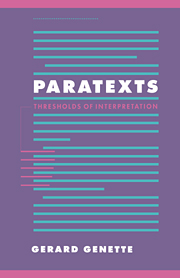Book contents
- Frontmatter
- Contents
- Foreword
- List of books by Gérard Genette
- Translator's note
- 1 Introduction
- 2 The publisher's peritext
- 3 The name of the author
- 4 Titles
- 5 The please-insert
- 6 Dedications and inscriptions
- 7 Epigraphs
- 8 The prefatorial situation of communication
- 9 The functions of the original preface
- 10 Other prefaces, other functions
- 11 Intertitles
- 12 Notes
- 13 The public epitext
- 14 The private epitext
- 15 Conclusion
- Additional references
- Index
10 - Other prefaces, other functions
Published online by Cambridge University Press: 04 November 2009
- Frontmatter
- Contents
- Foreword
- List of books by Gérard Genette
- Translator's note
- 1 Introduction
- 2 The publisher's peritext
- 3 The name of the author
- 4 Titles
- 5 The please-insert
- 6 Dedications and inscriptions
- 7 Epigraphs
- 8 The prefatorial situation of communication
- 9 The functions of the original preface
- 10 Other prefaces, other functions
- 11 Intertitles
- 12 Notes
- 13 The public epitext
- 14 The private epitext
- 15 Conclusion
- Additional references
- Index
Summary
Postfaces
The main disadvantage of a preface is that it constitutes an unbalanced and even shaky situation of communication: its author is offering the reader an advance commentary on a text the reader has not yet become familiar with. Consequently many readers apparently prefer to read the preface after the text, when they will know “what it's all about.” The logic of this situation should then lead the author to acknowledge such an impulse and offer a postface instead; here he could expatiate on his subject knowing that both sides were fully informed: “Now you know as much about it as I, so let's have a chat.” Further, I admit that at the start of this investigation I was expecting to encounter a corpus of original postfaces almost as abundant as the corpus of prefaces. But I found nothing of the kind: even given the very amateurish nature of my investigation, the meagerness of the corpus of original postfaces is conspicuous enough to be significant. I have already mentioned the “postscript” to Waverley and some “epilogues” by Borges – including that of The Book of Sand, which, moreover, invokes a supplementary motive peculiar to this genre: “Prefacing stories a reader has not yet read, since it demands the analysis of plots that it may be inconvenient to deal with in advance, is a somewhat impossible task. I therefore prefer an afterword.“
- Type
- Chapter
- Information
- ParatextsThresholds of Interpretation, pp. 237 - 293Publisher: Cambridge University PressPrint publication year: 1997



